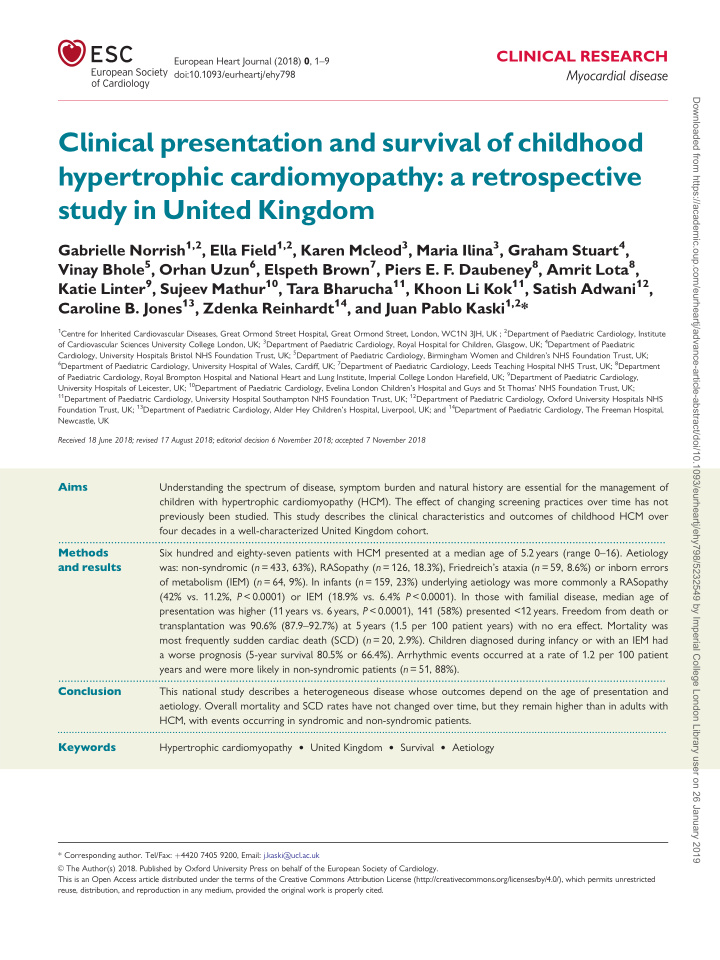



CLINICAL RESEARCH European Heart Journal (2018) 0 , 1–9 Myocardial disease doi:10.1093/eurheartj/ehy798 Downloaded from https://academic.oup.com/eurheartj/advance-article-abstract/doi/10.1093/eurheartj/ehy798/5232549 by Imperial College London Library user on 26 January 2019 Clinical presentation and survival of childhood hypertrophic cardiomyopathy: a retrospective study in United Kingdom Gabrielle Norrish 1,2 , Ella Field 1,2 , Karen Mcleod 3 , Maria Ilina 3 , Graham Stuart 4 , Vinay Bhole 5 , Orhan Uzun 6 , Elspeth Brown 7 , Piers E. F. Daubeney 8 , Amrit Lota 8 , Katie Linter 9 , Sujeev Mathur 10 , Tara Bharucha 11 , Khoon Li Kok 11 , Satish Adwani 12 , Caroline B. Jones 13 , Zdenka Reinhardt 14 , and Juan Pablo Kaski 1,2 * 1 Centre for Inherited Cardiovascular Diseases, Great Ormond Street Hospital, Great Ormond Street, London, WC1N 3JH, UK ; 2 Department of Paediatric Cardiology, Institute of Cardiovascular Sciences University College London, UK; 3 Department of Paediatric Cardiology, Royal Hospital for Children, Glasgow, UK; 4 Department of Paediatric Cardiology, University Hospitals Bristol NHS Foundation Trust, UK; 5 Department of Paediatric Cardiology, Birmingham Women and Children’s NHS Foundation Trust, UK; 6 Department of Paediatric Cardiology, University Hospital of Wales, Cardiff, UK; 7 Department of Paediatric Cardiology, Leeds Teaching Hospital NHS Trust, UK; 8 Department of Paediatric Cardiology, Royal Brompton Hospital and National Heart and Lung Institute, Imperial College London Harefield, UK; 9 Department of Paediatric Cardiology, University Hospitals of Leicester, UK; 10 Department of Paediatric Cardiology, Evelina London Children’s Hospital and Guys and St Thomas’ NHS Foundation Trust, UK; 11 Department of Paediatric Cardiology, University Hospital Southampton NHS Foundation Trust, UK; 12 Department of Paediatric Cardiology, Oxford University Hospitals NHS Foundation Trust, UK; 13 Department of Paediatric Cardiology, Alder Hey Children’s Hospital, Liverpool, UK; and 14 Department of Paediatric Cardiology, The Freeman Hospital, Newcastle, UK Received 18 June 2018; revised 17 August 2018; editorial decision 6 November 2018; accepted 7 November 2018 Aims Understanding the spectrum of disease, symptom burden and natural history are essential for the management of children with hypertrophic cardiomyopathy (HCM). The effect of changing screening practices over time has not previously been studied. This study describes the clinical characteristics and outcomes of childhood HCM over four decades in a well-characterized United Kingdom cohort. ................................................................................................................................................................................................... Methods Six hundred and eighty-seven patients with HCM presented at a median age of 5.2 years (range 0–16). Aetiology and results was: non-syndromic ( n = 433, 63%), RASopathy ( n = 126, 18.3%), Friedreich’s ataxia ( n = 59, 8.6%) or inborn errors of metabolism (IEM) ( n = 64, 9%). In infants ( n = 159, 23%) underlying aetiology was more commonly a RASopathy (42% vs. 11.2%, P < 0.0001) or IEM (18.9% vs. 6.4% P < 0.0001). In those with familial disease, median age of presentation was higher (11 years vs. 6 years, P < 0.0001), 141 (58%) presented <12 years. Freedom from death or transplantation was 90.6% (87.9–92.7%) at 5 years (1.5 per 100 patient years) with no era effect. Mortality was most frequently sudden cardiac death (SCD) ( n = 20, 2.9%). Children diagnosed during infancy or with an IEM had a worse prognosis (5-year survival 80.5% or 66.4%). Arrhythmic events occurred at a rate of 1.2 per 100 patient years and were more likely in non-syndromic patients ( n = 51, 88%). ................................................................................................................................................................................................... Conclusion This national study describes a heterogeneous disease whose outcomes depend on the age of presentation and aetiology. Overall mortality and SCD rates have not changed over time, but they remain higher than in adults with HCM, with events occurring in syndromic and non-syndromic patients. � � � � � � � � � � � � � � � � � � � � � � � � � � � � � � � � � � � � � � � � � � � � � � � � � � � � � � � � � � � � � � � � � � � � � � � � � � � � � � � � � � � � � � � � � � � � � � � � � � � � � � � � � � � � � � � � � � � � � � � � � � � � � � � � � � � � � � � � � � � � � � � � � � � � � � � � � � � � � � � � � � � � � � � � � � � � � � � � � � � � � � � � � � � � � � � � � � � � � � � � � � � � � � � � � � � � Hypertrophic cardiomyopathy • United Kingdom • Survival • Aetiology Keywords * Corresponding author. Tel/Fax: þ 4420 7405 9200, Email: j.kaski@ucl.ac.uk C The Author(s) 2018. Published by Oxford University Press on behalf of the European Society of Cardiology. V This is an Open Access article distributed under the terms of the Creative Commons Attribution License (http://creativecommons.org/licenses/by/4.0/), which permits unrestricted reuse, distribution, and reproduction in any medium, provided the original work is properly cited.
Recommend
More recommend